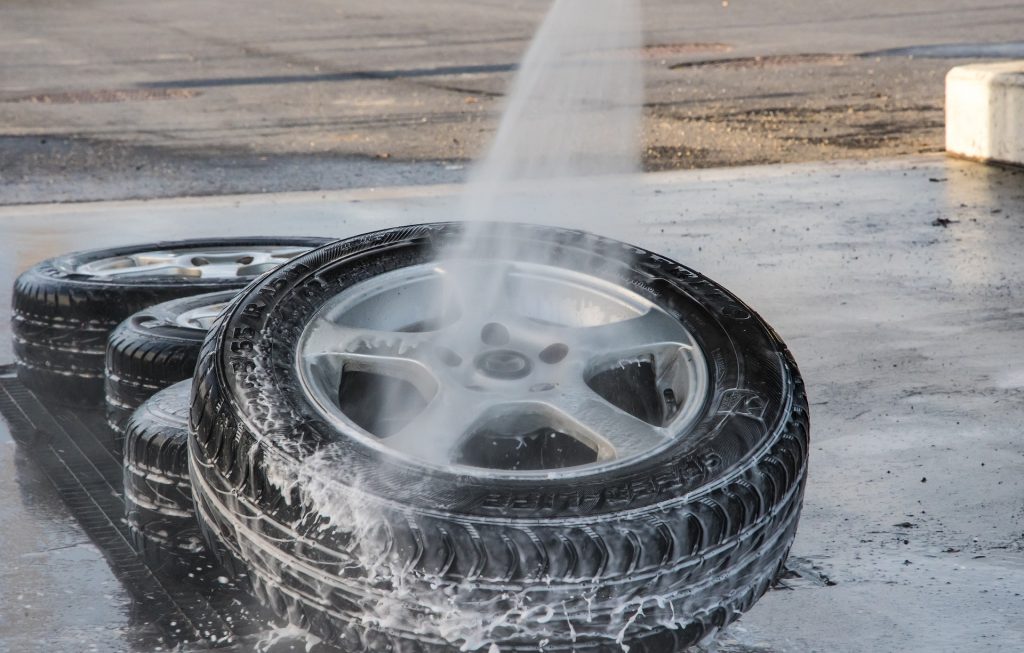‘I’m always surprised at how neglected tyres are, even among automotive enthusiasts, given how important they are to a car’s overall aesthetic and efficiency. Maintaining your vehicle hygienic can be difficult regularly, but cleaning your tyres is critical to preventing brake dust and other particles from damaging the tyre. (This is also a good opportunity to check your tyres to make sure they’re ready for your next journey!)
Tires are a vital component of your automobile, van, or motorbike. They deteriorate quickly due to use, exposure to the environment, and simply sitting. Over time, road tar, sand, salt, exhaust fumes, hydrocarbons, ultraviolet light, and gases all destroy your tyres. Even if your tyres aren’t worn out, it’s a good idea to change after five years to avoid sudden failure due to degraded rubber.
Tyres accumulate dirt faster than any other aspect of the vehicle’s exterior. It’s a good idea to set aside a few rags for tyre and wheel cleaning only because filth and brake dust can leave permanent stains. Use these rags solely on the wheels and tyres, as they may include brake dust and debris, which might harm other parts of the vehicle. Due to their extra makeup, low-cost tyre dressings, which are typically silicone-based, can hasten tyre breakdown. They can also cling to your paint, discolouring and destroying it.
The purpose of cleaning and polishing tyres is to enhance their look (make them look new) while also protecting them so they can endure a long period securely. It’s not just about making your tyres look nice. Keeping brake dust and other debris out of your tyres will help them last longer by preventing damage. So, how can you clean your tyres without causing damage to them or your wheels? Bridgestone Tyres Cheltenham‘s best tips for cleaning your tyres are below.
Cleaning for Tyres
You must first clean the tyres before applying a tyre treatment. Cleaning removes blooming and restores the tire’s black colour. As well as provides a better surface for the dressing to adhere to.
Also, it’s worth noting that many tyre cleaners contain chemical additives and soaps that might accelerate the disintegration of the outermost surface of the rubber and the blooming process. It is critical to start with the least aggressive method of cleaning your tyres and use commercial cleaners sparingly. It’s fine if some of the brownings remain after cleaning. It’s practically hard to get rid of everything. When you apply a quality tyre dressing, the brown tint will disappear.
You may just use your standard car cleaning soap or an all-in-one cleanser with a specialised wash glove or bristle brush on well-maintained tyres. You must use a specialised cleaner to eliminate the blooming on more neglected tyres. If you’re searching for a tyre cleaner, check sure it’s safe for your particular tyre shine.
Tyre Cleaning Instructions
The procedure for cleaning a tyre is quite simple:
- Using the hose, wash the tyre.
- Scrub each tyre backwards and forward motions with a specialised wash sponge, or bristle brush, using standard automotive shampoo and water.
- Using your hose, wash the tyre.
- If any dirt remains, pat the tyre thoroughly and sprinkle with cleaner.
- Using a wipe or brush, scrub backwards and forward.
- Rinse the tyre once again with water.
- Still, if the tyre is in poor condition, repeat the scrubbing using a tyre cleaner.
- Rinse a final time.
Tyre Shine
Ensure you’ve scrubbed the tires before applying a tire covering. Tire covering will stick to clean elastic better and have an all the more smooth and darkish appearance. White dividers and raised white lettering will likewise seem more pleasant.
There are numerous tyre coatings available, as well as numerous tyre and wheel cleaners. Tyre coating is into two kinds: liquid-based and dissolvable-based. Liquid-based dressings are a mix of engineered polymers and normally oils that move in water and frequently make a non-oily, matte dark to glossy silk finish on the tyre. It’s the “new tire” appearance instead of the oily plastic appearance of modest dissolvable cleaners.
Liquid-based coatings, then again, saturate and take care of the tyres instead of essentially laying on top or maybe throwing them onto the paint. Indeed many of them contain UV inhibitors, which give the tyre a coating of UV protection, preventing blurring, hardness, and breaking. Furthermore, liquid treatments are typically suitable.
The fundamental drawback of liquid coatings is their limited usability timeframe. If you drive your automobile in the downpour, the treatment’s shiny, silky dark appearance will fade after up to 14 days. You’ll obtain a short period of coverage and appeal if your car is a carport sovereign who maybe drives it when the weather is nice.
Coatings that expose to solvents, on the contrary, last longer. Engineered material in fluid tyre coatings is frequently used to transport chemicals and oils. Unfortunately, this gives out an oily, plastic-like odour. It does have a habit of bouncing off the tyres and onto the woodwork and paint in the surrounding.
The synthetic compounds in these dressings, particularly in low-cost, previously unknown treatments, might be brutal mostly on tyres over time, providing just a temporary benefit and ultimately throwing your money away.
Did you notice the tread depth was a little low while washing your tyres? Stop visit Leckhampton Tyres and MOT if you need new tyres. Our nationwide tyre and service warranty protects you from the unexpected. We can assist you in locating the right Car Tyres Cheltenham and wheels for your vehicle. Please stop by or make an appointment at your nearest shop, and we’ll take care of you!

